| No. | Portrait | Name
(birth–death) | Term of office | Monarch
Reign | Premier
Tenure |
|---|
| Took office | Left office |
|---|
| 1 |  | Henry William Stisted
(1817–1875) | 1 July
1867 | 14 July
1868 | Victoria
(1837–1901) | John Sandfield Macdonald
(1867–1871) |
| 2 | 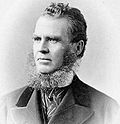 | William Pearce Howland
(1811–1907) | 15 July
1868 | 11 November
1873 |
Edward Blake
(1871–1872) |
Sir Oliver Mowat
(1872–1896) |
| 3 | 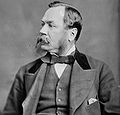 | John Willoughby Crawford
(1817–1875) | 12 November
1873 | 13 May
1875 |
| – |  | Sir William Buell Richards
(1815–1889)
Administrator of the Government | 13 May
1875 | 18 May
1875 |
| 4 | 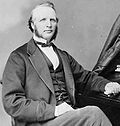 | Donald Alexander Macdonald
(1817–1896) | 18 May
1875 | 30 June
1880 |
| 5 |  | John Beverley Robinson
(1821–1896) | 1 July
1880 | 31 May
1887 |
| 6 |  | Sir Alexander Campbell
(1822–1892) | 1 June
1887 | 24 May
1892 |
| – |  | John Hawkins Hagarty
(1816–1900)
Administrator of the Government | 24 May
1892 | 30 May
1892 |
| 7 |  | George Airey Kirkpatrick
(1841–1899) | 30 May
1892 | 7 November
1896 |
Arthur Sturgis Hardy
(1896–1899) |
| – |  | Sir Casimir Gzowski
(1813–1898)
Administrator of the Government | {7 November
1896 | 18 November
1897 |
| 8 |  | Sir Oliver Mowat
(1820–1903) | 18 November
1897 | 19 April
1903 |
Sir George William Ross
(1899–1905) |
Edward VII
(1901–1910) |
| – |  | Sir Charles Moss
(1840–1912)
Administrator of the Government | 19 April
1903 | 21 April
1903 |
| 9 |  | Sir William Mortimer Clark
(1836–1915) | 21 April
1903 | 21 September
1908 |
Sir James Whitney
(1905–1914) |
| 10 |  | Sir John Morison Gibson
(1842–1929) | 21 September
1908 | 26 September
1914 |
George V
(1910–1936) |
| 11 |  | Sir John Strathearn Hendrie
(1857–1923) | 26 September
1914 | 20 November
1919 | Sir William Howard Hearst
(1914–1919) |
Ernest Charles Drury
(1919–1923) |
| 12 |  | Lionel Herbert Clarke
(1859–1921) | 20 November
1919 | 29 August
1921 |
| – |  | Sir William Ralph Meredith
(1840–1923)
Administrator of the Government | 29 August
1921 | 10 September
1921 |
| 13 |  | Henry Cockshutt
(1868–1944) | 10 September
1921 | 12 January
1927 |
Howard Ferguson
(1923–1930) |
| 14 |  | William Donald Ross
(1869–1947) | 12 January
1927 | 25 October
1931 |
George Stewart Henry
(1930–1934) |
| – | 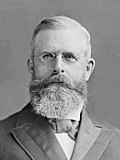 | Sir William Mulock
(1843–1944)
Administrator of the Government | 25 October
1931 | 1 November
1932 |
| 15 |  | Herbert Alexander Bruce
(1868–1963) | 1 November
1932 | 23 November
1937 |
Mitchell Hepburn
(1934–1942) |
Edward VIII
(1936) |
George VI
(1936–1952) |
| 16 |  | Albert Edward Matthews
(1873–1949) | 23 November
1937 | 26 December
1946 |
Gordon Daniel Conant
(1942–1943) |
Harry Nixon
(1943) |
George A. Drew
(1943–1948) |
| 17 |  | Ray Lawson
(1886–1980) | 26 December
1946 | 18 February
1952 |
Thomas Laird Kennedy
(1948–1949) |
Leslie Frost
(1949–1961) |
Elizabeth II
(1952–2022) |
| 18 |  | Louis Orville Breithaupt
(1890–1960) | 18 February
1952 | 30 December
1957 |
| 19 |  | John Keiller MacKay
(1880–1970) | 30 December
1957 | 1 May
1963 |
John Robarts
(1961–1971) |
| 20 |  | William Earl Rowe
(1894–1984) | 1 May
1963 | 4 July
1968 |
| 21 |  | William Ross Macdonald
(1891–1976) | 4 July
1968 | 10 April
1974 |
Bill Davis
(1971–1985) |
| 22 |  | Pauline Mills McGibbon
(1910–2001) | 10 April
1974 | 15 September
1980 |
| 23 |  | John Black Aird
(1923–1995) | 15 September
1980 | 20 September
1985 |
Frank Miller
(1985) |
David Peterson
(1985–1990) |
| 24 |  | Lincoln Alexander
(1922–2012) | 20 September
1985 | 10 December
1991 |
Bob Rae
(1990–1995) |
| 25 |  | Hal Jackman
(born 1932) | 11 December
1991 | 24 January
1997 |
Mike Harris
(1995–2002) |
| 26 |  | Hilary Weston
(1942–2025) | 24 January
1997 | 7 March
2002 |
| 27 |  | James Bartleman
(1939–2023) | 7 March
2002 | 5 September
2007 |
Ernie Eves
(2002–2003) |
Dalton McGuinty
(2003–2013) |
| 28 |  | David Onley
(1950–2023) | 5 September
2007 | 23 September
2014 |
Kathleen Wynne
(2013–2018) |
| 29 |  | Elizabeth Dowdeswell
(born 1944) | 23 September
2014 | 14 November
2023 |
Doug Ford
(since 2018) |
Charles III
(since 2022) |
| 30 | 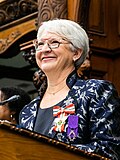 | Edith Dumont
(born 1964) | 14 November
2023 | |
| Source: [13] [14] |














































